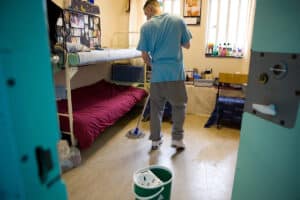Children banged up
Staffing problems meant far too many boys were locked up in cells nearly all day in young offender institutions.
That’s the headline finding of the annual report by HM Inspectorate of Prisons on the experiences of detained children aged 12 to 18.
Though the numbers who had felt unsafe in YOIs had fallen from a record high level in 2015–16, surveys in 2016–17 still found almost 40% had felt unsafe. Children in secure training centres (STCs), home to a larger number of under-16s, generally felt safer than those in YOIs but a fifth said they had no-one to turn to if they had a problem.

And in 2016–17, across both types of custody, there were disproportionate numbers of black and minority ethnic children, and children from Gypsy, Romany or Traveller communities, compared to their representation in the general population (see my summary of the Lammy Review). Children with disabilities and mental and emotional health problems, and with backgrounds in local authority care, were also held in high numbers.
The views of 720 children in custody
The report – Children in Custody 2016–17 – summarised findings of surveys distributed in HMIP inspections in the year. A total of 720 children completed the surveys. In his foreword, Peter Clarke, HM Chief Inspector of Prisons, recalled that in February 2017 he had warned ministers that none of the establishments holding children were judged in inspections to be safe and the speed of the decline in safety was “extraordinary”.
In 2016–17, Mr Clarke added,
the impact of staffing constraints appears to have been more keenly felt by children this year. In YOIs…we have found far too many boys being locked in their cells for more than of 22 hours each day, with staff struggling to manage the complexities of regimes where some boys can only be allowed out of their cells while others are locked up. Too often in STCs, we found that staff were being redeployed from their assigned unit to cover gaps elsewhere in the centre. More than a fifth of children in STCs said they had no one to turn to if they had a problem, meaning that many vulnerable children with complex needs were trying to manage their problems without support.
The Chief Inspector does remind us that ,oOverall, the numbers of children in custody has fallen by 70% since 2006–07 and the number of girls continues to fall – though Mr Clarke said it was important their specific needs were not overlooked.
Key findings
The report’s key findings include:
In STCs:
- Nearly half (49%) of children in STCs were from a black or other minority ethnic background. 12% said they were Muslim and 10% were from a Gypsy, Romany or Traveller background.
- More than one in five children (22%) reported feeling unsafe at some point since arriving at the STC.
In YOIs:
- Nearly half (48%) of boys identified themselves as being from a black or minority ethnic background. Around one-fifth (22%) were Muslim and the proportion of boys who had experienced local authority care was 42%. Almost one-fifth (19%) of boys reported having a disability.
- 39% of boys said they had felt unsafe, a fall on last year’s figure of 46%.
- There was a significant fall in the proportion of boys who said they could have a shower every day (71% compared with 88% in 2015–16) and the proportion who could use the phone every day had fallen significantly from 80% to 68%.
Half of the young people surveyed said they had been victimised by other young people and nearly a quarter by members of staff; details are shown in the table below which is reproduced in its entirety from the report:

Conclusion
In his conclusion, Mr Clarke makes no secret of the fact that problems continue to increase and that no progress has been made on the issues he raised the year before:
Last year, I invited those with the responsibility to develop and improve policy to take our findings seriously. I trust that the realignment of responsibilities between the Youth Justice Board, the Ministry of Justice commissioners of services and the new Youth Custody Service within HM Prison and Probation Service will lead to improvement, and that the process of restructuring and reform will not detract from the urgent need for an effective operational response to the issues raised in this report.
The need for this to be the case has actually increased, particularly when it comes to improving both the perceptions and the reality of safety. Until this is addressed, the broader objectives of delivering education, training and creating a rehabilitative environment will not be achieved.
All prison posts are kindly sponsored by Prison Consultants Limited who offer a complete service from arrest to release for anyone facing prison and their family. Prison Consultants have no editorial influence on the contents of this site.








